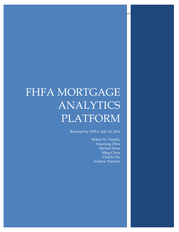Description
FHFA Working Paper 15-1
Jin, H. & Zhou, X. Y. (2013).
Greed, leverage, and potential losses: A prospect theory perspective. Mathematical Finance, 23, 122–142. Kahn, J. A. (2008).
What drives house prices? Tech. rep., Federal Reserve Bank of New York Staff Reports. No.
345. Mankiw, G. N. & Weil, D.
N. (1989). The baby boom, the baby bust, and the housing market. Regional Science and Urban Economics, 19, 235–258. Markowitz, H.
M. (1952). Portfolio selection.
Journal of Finance, 7, 77–91. Prais, S. & Winsten, C. (1954).
Trend estimators and serial correlation. Tech. rep., Cowles Foundation.
Discussion Paper 383. Reinhart, C. M. & Rogoff, K.
S. (2009). The aftermath of ï¬nancial crises.
Tech. rep., NBER. Working Paper 14656. Rousov´ , L. & van den Noord, P.
(2011). Predicting peaks and troughs in real house prices. Tech. a rep., OECD Economics Department Working Papers.
No. 882. Shiller, R. J.
(2007). Understanding recent trends in house prices and homeownership. Proceedings - Economic Policy Symposium - Jackson Hole, Federal Reserve Bank of Kansas City, 89–123. Smith, S., Fuller, D., Bogin, A., Polkovnichenko, N., & Weiher, J.
(2014). Countercyclical capital regime revisited: Tests of robustness. Tech.
rep., Federal Housing Finance Agency, Washington, DC. Working Paper 14-1. Smith, S. & Weiher, J.
(2012). Countercyclical capital regime: A proposed design and empirical evaluation. Tech.
rep., Federal Housing Finance Agency, Washington, DC. Working Paper 12-2. Van Nieuwerburgh, S. & Weill, P.-O.
(2010). Why has house price dispersion gone up? The Review of Economic Studies, 77, 1567–1606. Zietz, J. & Traian, A.
(2014). When was the U.S. housing downturn predictable? A comparison of univariate forecasting methods.
The Quarterly Review of Economics and Finance, 54, 271–281. 26 A. Bogin, S. Bruestle, & W.
Doerner — How Low Can House Prices Go? .
Greed, leverage, and potential losses: A prospect theory perspective. Mathematical Finance, 23, 122–142. Kahn, J. A. (2008).
What drives house prices? Tech. rep., Federal Reserve Bank of New York Staff Reports. No.
345. Mankiw, G. N. & Weil, D.
N. (1989). The baby boom, the baby bust, and the housing market. Regional Science and Urban Economics, 19, 235–258. Markowitz, H.
M. (1952). Portfolio selection.
Journal of Finance, 7, 77–91. Prais, S. & Winsten, C. (1954).
Trend estimators and serial correlation. Tech. rep., Cowles Foundation.
Discussion Paper 383. Reinhart, C. M. & Rogoff, K.
S. (2009). The aftermath of ï¬nancial crises.
Tech. rep., NBER. Working Paper 14656. Rousov´ , L. & van den Noord, P.
(2011). Predicting peaks and troughs in real house prices. Tech. a rep., OECD Economics Department Working Papers.
No. 882. Shiller, R. J.
(2007). Understanding recent trends in house prices and homeownership. Proceedings - Economic Policy Symposium - Jackson Hole, Federal Reserve Bank of Kansas City, 89–123. Smith, S., Fuller, D., Bogin, A., Polkovnichenko, N., & Weiher, J.
(2014). Countercyclical capital regime revisited: Tests of robustness. Tech.
rep., Federal Housing Finance Agency, Washington, DC. Working Paper 14-1. Smith, S. & Weiher, J.
(2012). Countercyclical capital regime: A proposed design and empirical evaluation. Tech.
rep., Federal Housing Finance Agency, Washington, DC. Working Paper 12-2. Van Nieuwerburgh, S. & Weill, P.-O.
(2010). Why has house price dispersion gone up? The Review of Economic Studies, 77, 1567–1606. Zietz, J. & Traian, A.
(2014). When was the U.S. housing downturn predictable? A comparison of univariate forecasting methods.
The Quarterly Review of Economics and Finance, 54, 271–281. 26 A. Bogin, S. Bruestle, & W.
Doerner — How Low Can House Prices Go? .









